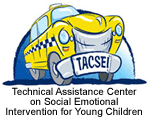2.9 Develop transition games, songs or other supports to ensure all children are actively engaged in the transition. Actively engage all children in the transition even those who are waiting their turn. Provide individual prompts (verbal, visual) to children who may have difficult transitioning.
 An example is illustrated in the photo: The daily schedule has been adapted for this child with visual impairment by creating a daily schedule with objects attached to the board to represent the daily routines, such as a toy car to represent taking big brother to school. Refer to the schedule throughout the day, allowing the child to manipulate and explore the objects in order to gain a better understanding of transitioning from one activity to another.
An example is illustrated in the photo: The daily schedule has been adapted for this child with visual impairment by creating a daily schedule with objects attached to the board to represent the daily routines, such as a toy car to represent taking big brother to school. Refer to the schedule throughout the day, allowing the child to manipulate and explore the objects in order to gain a better understanding of transitioning from one activity to another. - Develop routines within routines such as a transition sequence to help children through the schedule.
Watch: Transition sequence
- Plan for transitions when writing the lesson play for the week. Be sure to include more than one idea in case the children do not engage in the first activity. Examples have been illustrated in the CELLmini poster below.
Read: "Transitions and Waiting"


 An example is illustrated in the photo: The daily schedule has been adapted for this child with visual impairment by creating a daily schedule with objects attached to the board to represent the daily routines, such as a toy car to represent taking big brother to school. Refer to the schedule throughout the day, allowing the child to manipulate and explore the objects in order to gain a better understanding of transitioning from one activity to another.
An example is illustrated in the photo: The daily schedule has been adapted for this child with visual impairment by creating a daily schedule with objects attached to the board to represent the daily routines, such as a toy car to represent taking big brother to school. Refer to the schedule throughout the day, allowing the child to manipulate and explore the objects in order to gain a better understanding of transitioning from one activity to another.